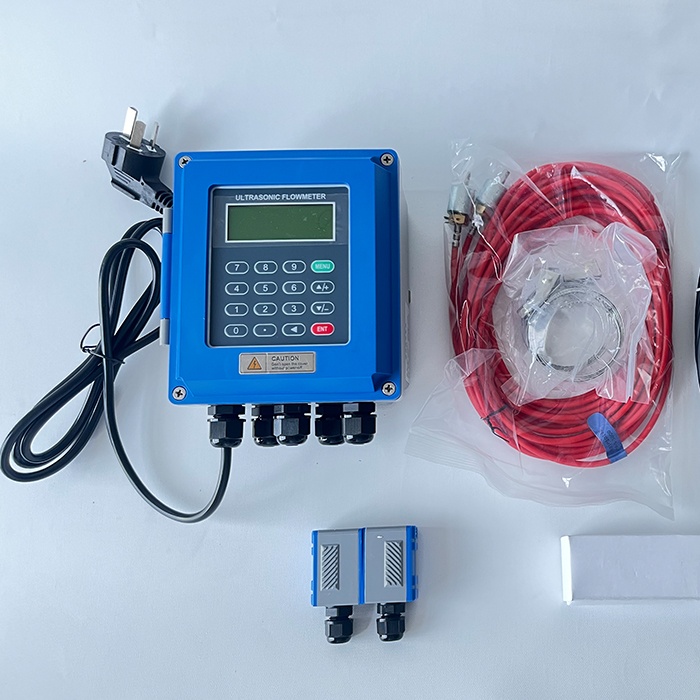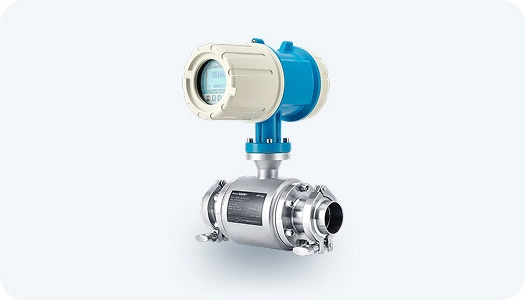-
Date:2025-11-11
-
Page View:17
An ultrasonic flowmeter is a commonly used instrument for measuring fluid flow, utilizing the propagation characteristics of ultrasonic waves to determine flow rate. When selecting the appropriate type of ultrasonic flowmeter, several factors must be considered, including measurement accuracy, fluid properties, pipe conditions, and the operating environment.
Classification by Sensor Installation Method
Clamp-On Ultrasonic Flowmeter
Features: A clamp-on ultrasonic flowmeter uses a special coupling gel, and its sensors are mounted on the outside of the pipe to measure flow. This installation method is simple, does not affect the pipeline system, and does not require shutting down the process. It is widely used for long-term, online flow measurement of various liquids.
Applications: Suitable for most liquid flow measurements, especially when pipe material or size is not suitable for other sensor types.
Insertion Ultrasonic Flowmeter
Features: An insertion ultrasonic flowmeter requires its sensors to be inserted into the interior of the pipe for measurement. This approach provides higher accuracy, especially in situations where the flow velocity distribution inside the pipe is uneven. Installation requires specialized tapping tools and is more complex, but the probe can be replaced under pressure without shutting down the system, making future maintenance easier.
Applications: Ideal for applications requiring high measurement accuracy, particularly in large-diameter or complex pipelines.
Inline (Spool-Type) Ultrasonic Flowmeter
Features: An inline ultrasonic flowmeter requires cutting into the main pipeline and installing the meter section using flange connections. Although installation is more involved, it offers higher measurement accuracy and allows maintenance without stopping production. This design eliminates accuracy issues seen in clamp-on and insertion sensors caused by irregular pipe geometry or installation errors.
Applications: Suitable for scenarios requiring high measurement accuracy, such as critical flow-measurement points in industrial processes.

ultrasonic water flow meters

portable ultrasonic flow meter
Classification by Additional Features
Handheld Ultrasonic Flowmeter
Features: A handheld ultrasonic flowmeter offers excellent mobility and extremely simple installation. It requires no pipe cutting and performs non-contact measurement. It is compact, easy to carry, accurate, and stable in performance. It includes a built-in data logger and can operate using an AC power source or its internal rechargeable battery.
Applications: Ideal for temporary flow or velocity measurements on various pipes in different locations.
Portable Ultrasonic Flowmeter
Features: A portable ultrasonic flowmeter includes a built-in rechargeable battery, is easy to transport, and can be used in harsh outdoor environments. It is suitable for short-term comparison measurements and on-site verification.
Applications: Widely used for periodic verification and comparison of ultrasonic flowmeters in industrial settings.
Fixed Ultrasonic Flowmeter
Features: A fixed ultrasonic flowmeter is designed for long-term, online flow measurement of various liquids. It uses reliable data-transmission methods and remote-monitoring capabilities, providing real-time data and displaying instantaneous and cumulative flow values.
Applications: Commonly used in industrial production, water treatment, and environmental monitoring for long-term, stable flow measurement.
Open-Channel Ultrasonic Flowmeter
Features: An open-channel ultrasonic flowmeter is used to measure wastewater discharge in natural or constructed flow channels. It integrates hydraulic flow measurement, ultrasonic level detection, microcomputer processing, and digital display. It can be installed in harsh environments and perform automatic measurement.
Applications: Widely used by environmental companies and in wastewater treatment, petroleum, chemical, chemical fiber, and pharmaceutical industries for wastewater discharge monitoring. It is one of the key instruments used by cities and environmental authorities for pollution monitoring.
Ultrasonic flowmeters can be classified into many types based on sensor installation methods and additional features. Each type has its own unique characteristics and application scenarios. In practical use, the appropriate type should be selected according to specific measurement requirements and environmental conditions.
When selecting a type of ultrasonic flow meter, you need to consider the characteristics of the fluid, such as its composition, temperature, pressure, viscosity, and conductivity. Different types of ultrasonic flow meters vary in how well they adapt to these fluid properties, so the choice should be based on actual operating conditions.
In addition, pipeline conditions are also an important factor when choosing the right ultrasonic flow meter. The shape, material, inner diameter, and internal wall condition of the pipe can all affect the performance of the meter. Therefore, selecting the right type of ultrasonic flow meter requires a comprehensive assessment of the pipeline conditions to ensure accurate and reliable measurement results.










